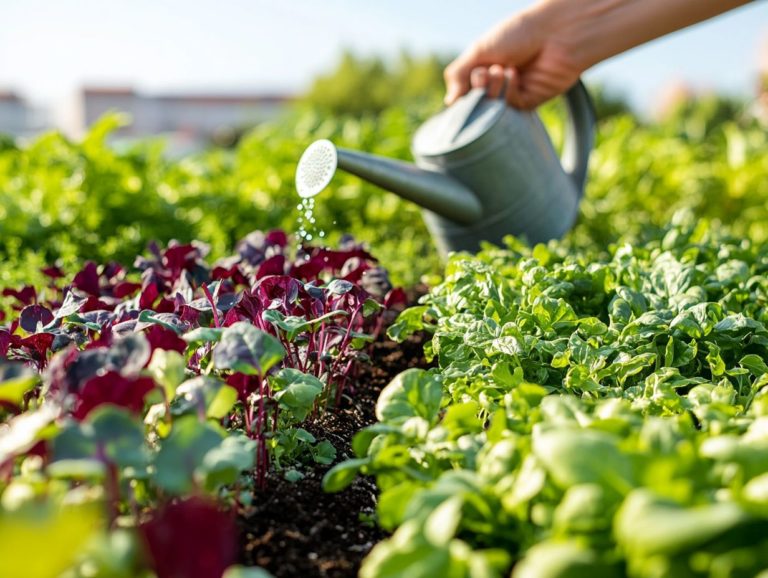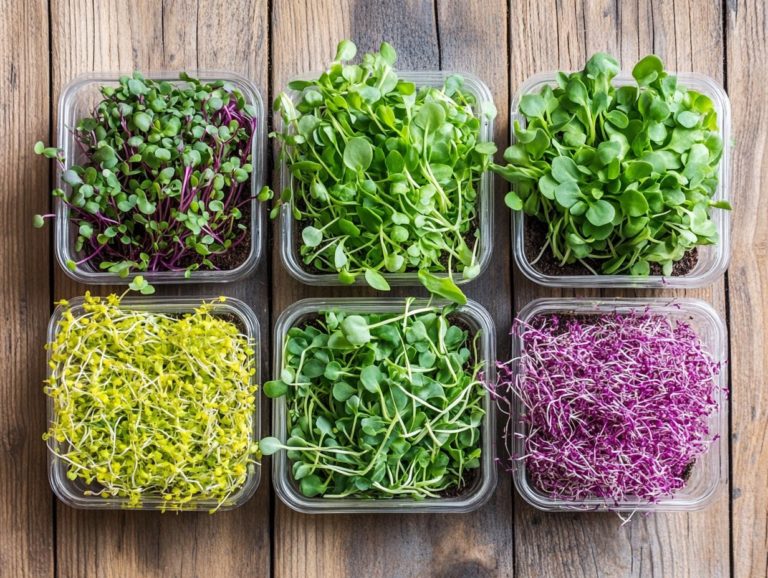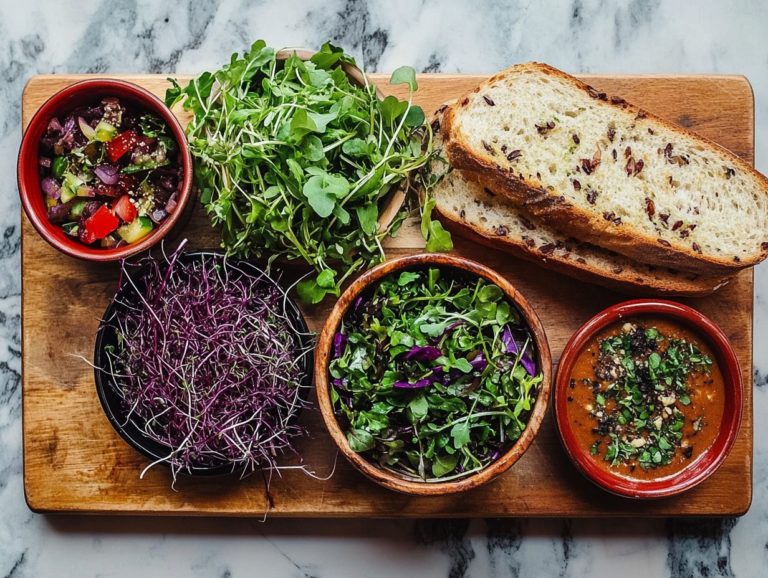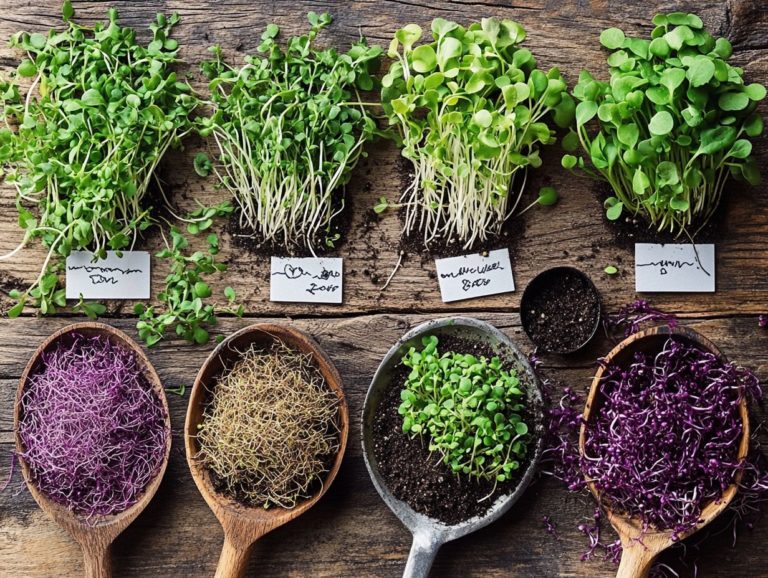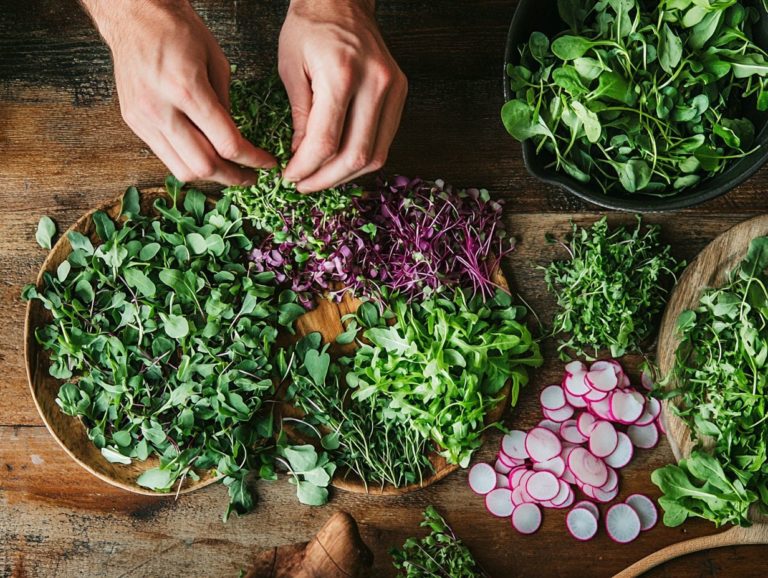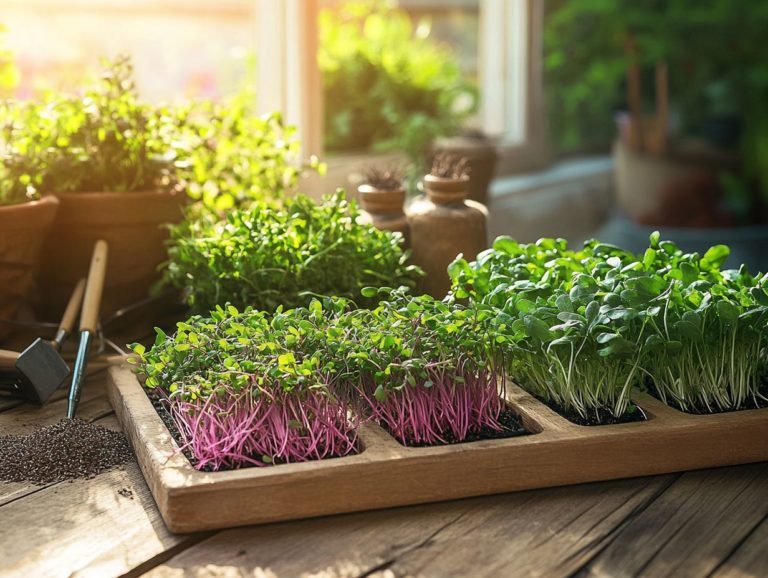How Microgreen Varieties Impact Culinary Presentation
Microgreens are more than just a trend they’re vibrant flavor boosters that can elevate any dish!
This article delves into the captivating world of microgreens. We ll outline their diverse types, including high-value vegetables like asparagus, and highlight their significant roles in culinary presentation.
Discover how microgreens can transform your meals! From their striking colors and unique textures to innovative plating techniques, you ll learn how to incorporate these petite greens into your dishes for maximum impact.
You can learn where to find them or how to cultivate your own for a fresh touch that brings your kitchen to life.
Contents
- Key Takeaways:
- Why Microgreens are Used in Culinary Presentation
- Types of Microgreens and Their Impact on Presentation
- How to Incorporate Microgreens into Dishes
- Where to Source Microgreens for Culinary Use
- Tips for Growing Your Own Microgreens
- Supplies and Techniques for Home Growing
- Frequently Asked Questions
- What are microgreens and how do they impact culinary presentation?
- What are the most commonly used microgreen varieties in culinary presentations?
- How do microgreen varieties impact the taste of a dish?
- Can microgreens be used in any type of cuisine?
- How can microgreen varieties be used as a garnish in culinary presentation?
- Are there any nutritional benefits to using microgreen varieties in culinary presentations?
Key Takeaways:

- Microgreens add both visual appeal and enhanced flavor to dishes, making them a popular choice for culinary presentation, which is crucial for chefs and restaurants.
- The variety of colors and textures among different microgreen types allows for creative and aesthetically pleasing plating options.
- Microgreens can be sourced from local farms and online options, or grown at home with the right supplies and techniques.
Definition and Types of Microgreens
Microgreens are delightful young plants that you can harvest at their freshest, usually between 7 to 21 days after they sprout. These petite greens encompass a wide variety of vegetables and herbs, showcasing a stunning array of colors and flavors while packing a powerful nutritional punch. They contain numerous healthy substances that benefit your body.
Consider the nutrient-dense options like arugula and kale, or the flavorful profiles of basil and cilantro; each type brings its own unique advantages. For instance, beet microgreens not only catch the eye with their vibrant color but are also rich in antioxidants. Broccoli microgreens, on the other hand, are praised for their potential cancer-fighting properties thanks to sulforaphane, a compound believed to help fight cancer. To explore even more, check out these must-try microgreen varieties for salads.
These tiny powerhouses elevate the flavor and presentation of your meals. They also support local farming practices and sustainability. For culinary professionals, exploring microgreen varieties can enhance your dishes. Their rapid growth cycle makes them an ideal choice for home gardeners, contributing to improved nutrition security in your community.
Why Microgreens are Used in Culinary Presentation
Microgreens have become incredibly popular in the culinary world, and it’s easy to see why. Their striking visual appeal and potent flavors make them a standout choice for chefs and restaurants eager to enhance their dishes.
These gourmet greens do more than just beautify a plate; they deliver a burst of flavor that can turn an ordinary meal into an extraordinary culinary experience.
Aesthetics and Flavor Enhancement
The aesthetics of microgreens play a pivotal role in culinary presentation. Their vibrant colors and delicate textures significantly enhance the visual appeal of a dish, making it all the more enticing to diners.
These tiny, nutrient-packed greens don’t just beautify the plate; they also introduce a range of sensory qualities that elevate the entire dining experience. For example, the crispness of radish microgreens delivers a peppery kick, while the gentle sweetness of pea shoots offers a delightful contrast. To explore more about these greens, check out microgreen varieties: a guide for beginners. Their diverse flavors complement and balance heavier ingredients, transforming each bite into a journey of taste.
Whether you sprinkle them on gourmet entrées or vibrant salads, these small greens create a captivating interplay between visual allure and flavor, inviting diners to fully indulge their senses. Exploring the benefits of growing diverse microgreen varieties can enhance both taste and presentation.
Types of Microgreens and Their Impact on Presentation
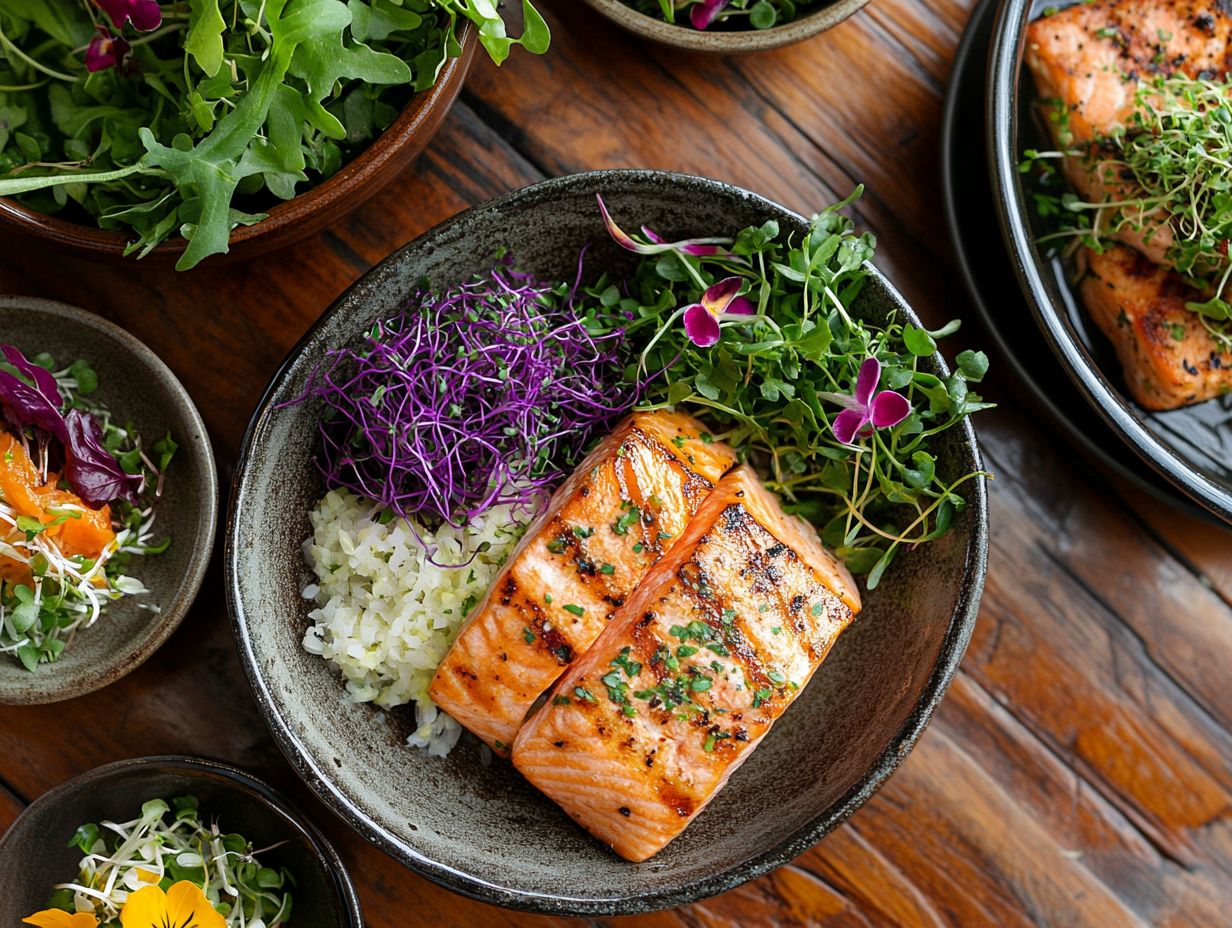
Numerous types of microgreens await your discovery, each adding its own unique flair to the presentation and flavor of culinary creations.
This variety offers you, as a chef, limitless opportunities to innovate and captivate your diners.
Color and Texture Variations
The color variations among different types of microgreens present a vibrant palette. Their diverse textures create intriguing contrasts that enhance the overall presentation of any dish.
These tiny greens not only inject a burst of color from deep purples to bright greens but also provide a delightful crunch or tenderness that can elevate a simple plate into a great dish. To explore different options, check out our microgreen varieties: taste and flavor guide.
Both chefs and home cooks appreciate how incorporating various microgreens, like crimson red amaranth and delicate pea shoots, can transform a dish’s visual appeal. The interplay of colors and textures invites you to engage more fully with your meal, inspiring creativity and innovation in your recipe development. For those interested in starting their own microgreens, learning how to choose microgreen varieties for your garden can be incredibly beneficial.
How to Incorporate Microgreens into Dishes
Incorporating microgreens into your dishes can truly elevate their flavor profiles and visual appeal. Chefs often use a range of plating techniques to showcase these delicate greens.
Creative Plating Techniques
Creative plating techniques that incorporate microgreens can elevate a simple dish into a visually stunning masterpiece, reflecting your cooking skills and meticulous attention to detail.
By thoughtfully positioning these vibrant greens, you not just add a splash of color and texture, but also enhance the overall dining experience. Different varieties of microgreens bring unique flavor profiles to the table.
Employing techniques like layering, scattering, and using microgreens as garnishes transforms an ordinary meal into an engaging visual narrative. This technique sparks your creativity and excitement in the kitchen!
Where to Source Microgreens for Culinary Use
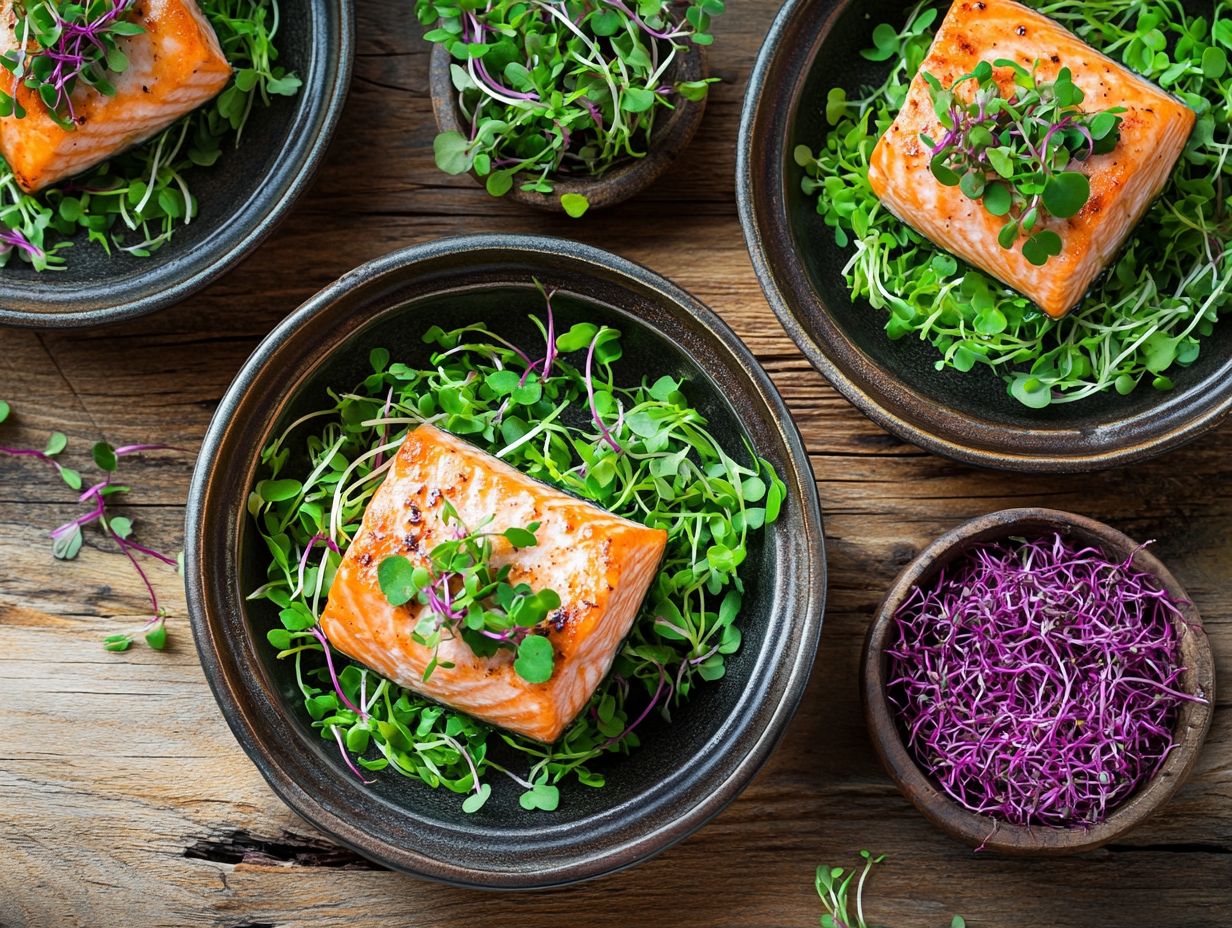
Sourcing high-quality microgreens for culinary purposes can be accomplished through a variety of channels, ranging from local farms to online vendors. This accessibility ensures that chefs and restaurants dedicated to using fresh ingredients have ample opportunities to incorporate these vibrant, nutrient-rich greens into their dishes.
Local Farms and Online Options
Local farms and online suppliers are your go-to sources for acquiring fresh microgreens, offering you a diverse array to enhance your culinary creations.
Sourcing microgreens from local farms comes with distinct advantages. When you choose ingredients from nearby farms, you enjoy unmatched quality and freshness, as the produce is harvested and delivered in record time.
This proximity ensures that your microgreens retain their vibrant flavors and nutritional value, while also allowing you to forge relationships with growers. These connections provide valuable insights into their growing practices and the seasonal variations in produce, including a quick guide to common microgreen varieties.
By opting for local sources, you not only support agricultural sustainability but also contribute to community resilience. Additionally, exploring microgreen varieties can create a remarkable synergy for both your kitchen and the environment.
Tips for Growing Your Own Microgreens
Cultivating your own microgreens at home offers a truly rewarding experience. You’ll enjoy fresh, nutritious gourmet greens while indulging in the delightful opportunity to experiment with diverse growing techniques and supplies.
Ready to transform your dishes? Try adding a sprinkle of microgreens today!
Supplies and Techniques for Home Growing
Essential supplies and techniques for home growing microgreens include seed trays, soil alternatives, and proper lighting to ensure successful germination and growth.
Invest in a quality watering can or spray bottle to maintain optimal moisture levels; after all, microgreens thrive in consistently damp environments. Temperature is crucial too, so keep your growing area between 65 F and 75 F to maximize the health of your plants. Using fluorescent or LED grow lights will provide the necessary light spectrum for photosynthesis, especially when natural sunlight is limited. To further enhance your dishes, consider incorporating unique microgreens into your meals.
By understanding these growth conditions and equipping yourself with the right supplies, you can significantly enhance your crop yields, transforming your gardening endeavor into a deeply satisfying and rewarding experience.
Frequently Asked Questions
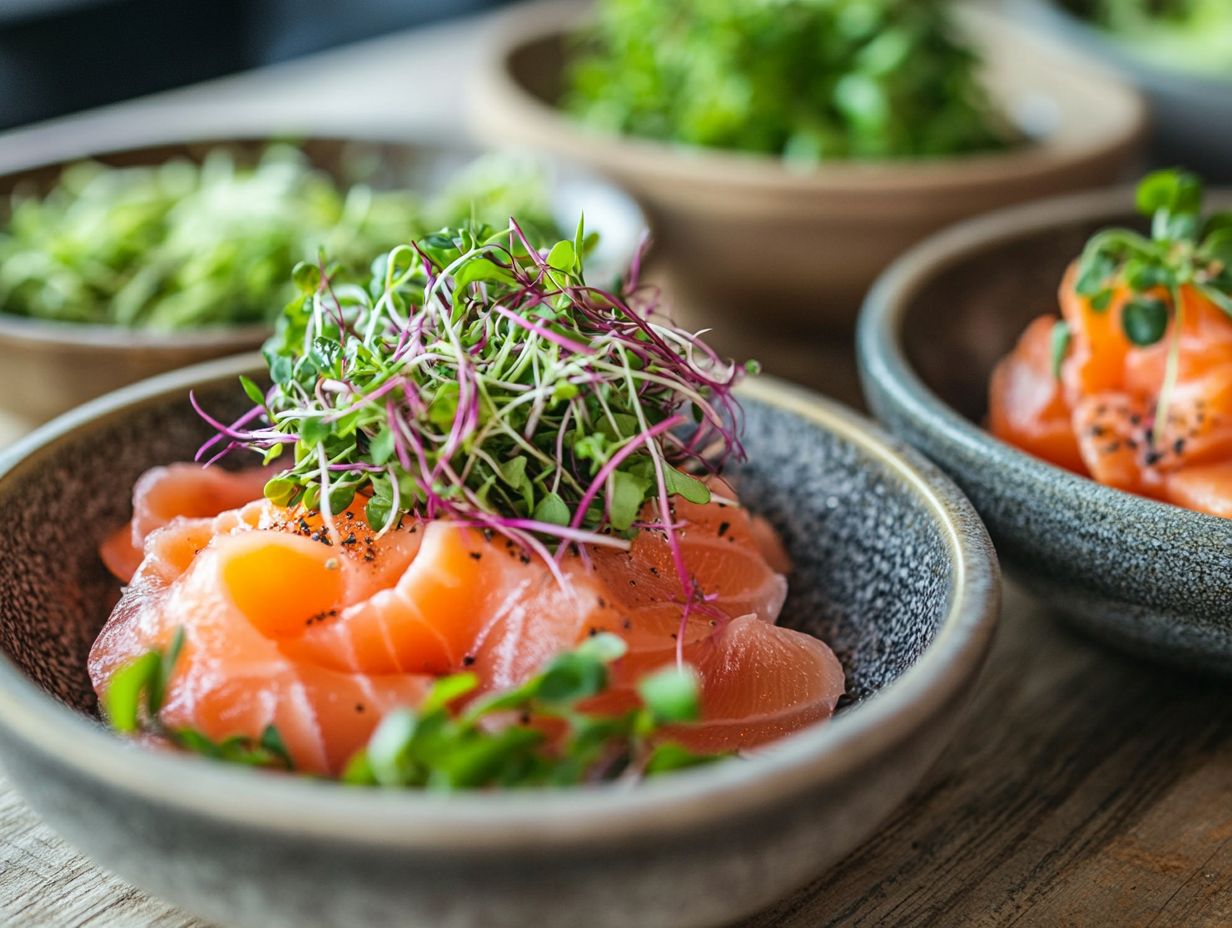
What are microgreens and how do they impact culinary presentation?
Microgreens are young, edible plants harvested when they are just a few inches tall. They come in various plant types and colors, making them a versatile and visually appealing addition to any dish. Their delicate size and striking appearance can greatly enhance the overall presentation of a dish.
What are the most commonly used microgreen varieties in culinary presentations?
Some popular microgreen varieties used in culinary presentations include pea shoots, radish sprouts, sunflower shoots, and micro basil. These not only add texture and color to a dish but also provide unique flavors that complement the main ingredients.
How do microgreen varieties impact the taste of a dish?
Microgreens can strongly affect the taste of a dish. Some have mild and subtle flavors, while others offer intense and distinct tastes. The type of microgreen used can elevate the overall flavor of a dish, providing a pleasant surprise to the palate. For instance, varieties from the Brassicaceae family, which includes broccoli and cabbage, can add unique flavors and health-promoting phytochemicals.
Can microgreens be used in any type of cuisine?
Yes! Microgreens can be used in various cuisines, from Asian to Mediterranean to American. Their versatility allows them to be incorporated into a wide range of dishes, from salads to soups to main courses. Urban farming practices can facilitate the growth of these immature plants, providing fresh ingredients year-round.
How can microgreen varieties be used as a garnish in culinary presentation?
Get creative! Use microgreens to sprinkle color and flair on your dishes. They can be added on top to provide a pop of color, used to create decorative designs, or even as a bed for the main ingredients. These techniques enhance presentation and can contribute to the nutritional profile, adding vitamins and minerals.
Are there any nutritional benefits to using microgreen varieties in culinary presentations?
Yes, microgreens are small edible plants harvested just after the first leaves have developed. They are packed with nutrients, making them a healthy addition to any dish.
These tiny greens are rich in vitamins, minerals, and antioxidants. Adding them to your meals can significantly boost nutrition.
They play a crucial role in preventing malnutrition and combating chronic conditions like obesity, type 2 diabetes, and heart disease. During the pandemic, sourcing nutrient-dense foods like microgreens became essential for maintaining a healthy diet.

